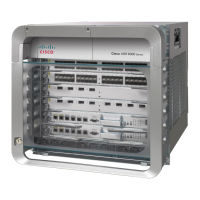37
Cisco ASR 9000 Series Aggregation Services Router Getting Started Guide
OL-28417-02
Configuring General Router Features
This chapter describes how to communicate with the router using the command-line interface (CLI), and
it also shows basic Cisco IOS XR software configuration management.
Contents
• Connecting and Communicating with the Router, page 38
• Logging In to a Router or an SDR, page 51
• CLI Prompt, page 52
• User Access Privileges, page 53
• Navigating the Cisco IOS XR Command Modes, page 57
• Managing Configuration Sessions, page 66
• Configuring the SDRRSP Hostname, page 85
• Configuring the Management Ethernet Interface, page 85
• Manually Setting the Router Clock, page 92
• Where to Go Next, page 94
Connecting and Communicating with the Router
Connections are made either through a direct physical connection to the console port .
When the router is directly connected to the Console port, enter CLI commands at a terminal or at a
computer running terminal emulation software. This direct Console port connection is useful for
entering initial configurations and performing some debugging tasks.
This chapter describes some of the tasks to perform during your initial configuration. One of those tasks
is the configuration of the Management Ethernet interface, which is described in the “Configuring the
Management Ethernet Interface” section on page 85. After the Management Ethernet interface is
configured, most router management and configuration sessions take place over an Ethernet network
connected to the Management Ethernet interface. SNMP agents also use the network connection.
You can use the modem connection for remote communications with the router. If the Management
Ethernet interface fails, the modem connection serves as the alternate remote communications path.
The following sections describe three ways to connect to the router:

